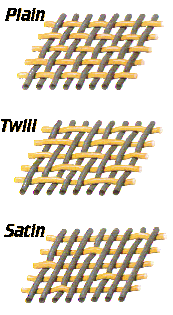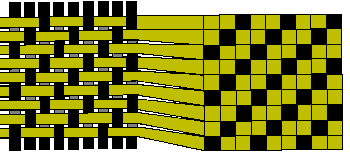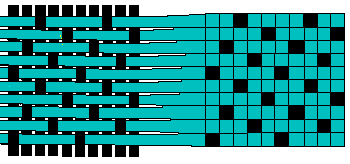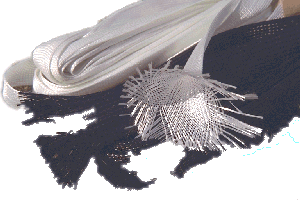WOVEN
MATERIALS
Times change. Over a decade or
two ago I recall lusting after the latest model from Graupner - the
Cumulus. It was then state of the art with white
foam wings covered in balsa but now no it's longer available. The
fuselage was some sort of nylon material and therefore very
robust. Carbon fibre, Rohacell and Nomex were unheard of at that
time. The latest all moulded models these days have carbon fibre
skins and Kevlar™ reinforced glass fuzzes, the sandwich
material may be the expensive Rohacell foam or even Nomex
honeycomb but more often than not it's soft balsa.
So what are these materials?
Read on then and we'll have a look at a few of the composite
materials used in models today. I'll start with woven materials
for the reinforcement of resin matrixes.
 Everyone reading this will have encountered fibre
glass fuselages but very few will have made one for themselves
from a mould. Moulding does give you experience and the ability
to judge and appreciate the efforts of others. If you were going
to do some moulding which materials would you use and why? Cheque
book fliers miss so much in this respect. For those uninitiated
souls and beginners, here's a few pointers on the cloth available
for aeromodelling. Later articles will cover foam and resin
addtives.
Everyone reading this will have encountered fibre
glass fuselages but very few will have made one for themselves
from a mould. Moulding does give you experience and the ability
to judge and appreciate the efforts of others. If you were going
to do some moulding which materials would you use and why? Cheque
book fliers miss so much in this respect. For those uninitiated
souls and beginners, here's a few pointers on the cloth available
for aeromodelling. Later articles will cover foam and resin
addtives.
GLASS FIBRE
There are several different
types of glass fibre - the one we usually use is called E-Glass -
a description going to back to the early days when glass was used
primarily for E-electrical insulation. This is not the strongest
glass available, that is given by a S-Glass not so common here
but you may see it advertised for sale in the States. A-Glass is
a third type of glass, the lowest strength/quality often used in
chopped strand matt for simple filling. Since the fibres are not
woven and therefore have no coherent direction, chopped strand
adds only a little strength to resin matrixes. Even so it is
still a useful material for filling although a little heavy. In
fact, glass is the heaviest of reinforcement materials with a
density (S.G. if you prefer) of ~2.5g/cm³.
CARBON FIBRE
I love carbon fibre - it's easy
to work and provides exceptional strength. It does have the
drawback that it's expensive, an order of magnitude more than
glass fibre, especially the lighter weaves; it's also very
brittle and snaps suddenly with little bending beforehand. It's
lighter than glass too coming in at ~1.8g/cm³. Areal weights are
generally 100-200 gsm although I see that woven carbon is now
available in Germany at 60 gsm - whether this is a result of a
loose weave or some lighter variant of carbon fibre itself I do
not know. Certainly, it's a useful addition to the range of
cloths available for tailplanes, HLG's and the like.
ARAMID FIBRE
This is the yellowish material
fuselages are made of, or reinforced with. I personally try to
avoid using it because of the fuzzing you get when trying to sand
exposed material. It has the benefit of being rather good at
sustaining impacts (cf. bullet proof vests and body armour) and
is therefore ideal for fuselages. It is no where near as brittle
as either glass or carbon fibre. It's the lightest so far of the
materials with a density of ~1.45g/cm³. It's also often known as
Aramid fibre . The type used for models is Kevlar 49 - different
types such as Kevlar 29 and Twaron have different properties.
POLYETHYLENE
FIBRE
Spectra, the latest in the line
of modeller materials, is the lightest material so far with a
density of 0.97g/cm³ less than water. It is a long chain
polythene chain molecule with a high impact resistance and the
highest strength to weight ratio so far. Like aramid fibre it has
the drawback of fuzzing when worked on. I have used it and like
the idea of using it - but working is problematical as I say.
Surprisingly little used. Spectra is the US name, in Europe it's
called Dyneema. If you're into fishing or kite flying you will
have come across these two fibres already.
WARP AND WEFT
 Many modellers still ask which fabric they should
use for moulding, unclear as to the relative merits of plain,
twill and satin weaves. Unaided, pretty soon they realise that
plain weaves are not much good for moulding fuselages - don't get
me wrong, it can be done but there are better choices. What is
the difference in these weaves, then? Let's begin with
Uni-Directional materials. Simply the fibres or tows of fibres
all run in one direction, UD comes with a few weft threads of
glass or aramid woven in or even some sort of backing material to
keep them in order. Fine they may be for some wings but not for
surfaces where strength is needed in more than one direction so
we choose a woven material. The following weaves are in order of
their drape, strength and generally, expense.
Many modellers still ask which fabric they should
use for moulding, unclear as to the relative merits of plain,
twill and satin weaves. Unaided, pretty soon they realise that
plain weaves are not much good for moulding fuselages - don't get
me wrong, it can be done but there are better choices. What is
the difference in these weaves, then? Let's begin with
Uni-Directional materials. Simply the fibres or tows of fibres
all run in one direction, UD comes with a few weft threads of
glass or aramid woven in or even some sort of backing material to
keep them in order. Fine they may be for some wings but not for
surfaces where strength is needed in more than one direction so
we choose a woven material. The following weaves are in order of
their drape, strength and generally, expense.
- WARP =
Lengthwise threads, i.e. they run the
length of the roll of woven cloth.
- WEFT = The
transverse, or crosswise, threads woven
into the warp threads.
- DRAPE = The
way the cloth drapes over or fits into
compound curves.
- AREAL
WEIGHT = Weight of cloth generally in gsm
(gram per square metre)
- SIZE = Nearly all fabrics
are sized or coated with epoxy resin (~1%) for
adhesion.
- BIAS = The angle of the
warp and weft threads, usually 90º but can be 45º.
- UD = Uni-directional. Tows
of fibres held in position in a scaffold of fine weft
threads.
 PLAIN WEAVE
PLAIN WEAVE
The simplest fabric to
understand is a Plain Weave; it's simply over and under in
each direction. (That is to say; the weft is carried over all
odd-numbered warps and under all even-numbered warps. For the
next pass of the shuttle, the weft passes over the even-numbered
warps, and under the odd.) Sometimes it's two over and two under.
It has the advantage of giving strength in both directions with a
90º bias but the disadvantage of halving the UD strength (since
half the cloth is at 90º). Another disadvantage of the plain
weave is that the cloth is bent over and under which imparts some
shearing distress on the fibres therefore weakening them compared
to UD fibre which lays flat. Plain weaves will curve over simple
one-way curves but with compound curves there can be a problem.
Try pushing some in a mould and you'll find out - you'll end up
with wrinkles and will have to snip the cloth here and there if
you're not careful. The finest plain weave glass is about 25gsm.
(German Plain = Leinwand)
 TWILL WEAVES
TWILL WEAVES
Twill Weaves are better at
handling compound curves than plain weaves. Look closely at the
diagrams and you'll see the way the weave is formed. (The twill
is formed when the weft passes over warps 1 and 2 and under warps
3 and 4, and in the next pass, the shuttle of the loom passes
over warps 2 and 3 and under warps 4 and 5.) There are many
variations on the theme so you will see twills listed as 1/2,
2/2, 1/3, etc. Twill fabrics are characterised by their appearing
to have diagonal lines running either right or left on the fabric
face.The first advantage is the fewer number of times the fibres
go under and over one another. A variation of the twill is the
Crowsfoot or cross twill. Twill weaves feel generally tighter, or
more closely woven, than plain weaves. For most purposes a nice
100 - 160gsm twill is the best choice. (German Twill = Köper.)
 SATIN WEAVE
SATIN WEAVE
In the Satin Weave, the weft floats
or skips over as many as 12 warps before being woven in. The next
pick repeats the float, but on a different set of warps. Compare
the weft over the warp threads in the diagram below. You may see
satin fabrics labelled as 5 or 8 harness satin weaves indicating
the degree of float. The one here is a 5 harness - the weft
floats over 4 warp threads. In Germany these weaves are called
Atlas verbindung. These are probably the best fabrics to use for
complex moulds but can appear to be tightly woven and therefore
difficult to wet out with resin. Since the threads have less crimping
than plain and twill, satins make for the strongest use of the
fibres.

HYBRID MATERIALS
In an attempt to harness the
stiffness and compressive strength of carbon fibre with the
impact resistance and tensile strength of aramid fibre, hybrid
fabrics are also available. These come in many forms - the
carbon/aramid twills have rather nice yellow and black patterns
to them too. I actually have some rather nice UD carbon and UD
Dyneema with a 45º bias.
PREPREG MATERIAL
As its name suggests, prepreg is
pre-impregnated material i.e. impregnated with mixed epoxy resin.
It comes with a backing paper and has a limited shelf life and
must be stored in cool conditions. Pre-preg carbon has the
appearance of sticky liquorice. This material is NOT suitable for
modelling since autoclaves and high temperatures are needed to
cure the resin. Newer types use thermoplastics instead of Epoxy
resins and are like stiff plastic until softened by heat, e.g
PEEK (polyethyl ether ketone).
 BRAIDING
(gewebeschläuche)
BRAIDING
(gewebeschläuche)
Special type of woven cloth - a
woven tubing if you like - rather like a Chinese finger puzzle.
It's sometimes called braid. Ideal for spars, fuselage booms,
fuselage pods, engine nacelles, etc where no seam is required. It
effectively forms a spiral weave for cylindrical objects and
pulls round compound curves. I used it with the lost foam method
to make an HLG fuselage. Available, only from Germany and the USA
as far as I know, in glass, carbon, aramid and carbon/aramid
hybrid forms. Many diameters from 5 mm up to 150 mm before
stretching.
 Everyone reading this will have encountered fibre
glass fuselages but very few will have made one for themselves
from a mould. Moulding does give you experience and the ability
to judge and appreciate the efforts of others. If you were going
to do some moulding which materials would you use and why? Cheque
book fliers miss so much in this respect. For those uninitiated
souls and beginners, here's a few pointers on the cloth available
for aeromodelling. Later articles will cover foam and resin
addtives.
Everyone reading this will have encountered fibre
glass fuselages but very few will have made one for themselves
from a mould. Moulding does give you experience and the ability
to judge and appreciate the efforts of others. If you were going
to do some moulding which materials would you use and why? Cheque
book fliers miss so much in this respect. For those uninitiated
souls and beginners, here's a few pointers on the cloth available
for aeromodelling. Later articles will cover foam and resin
addtives.  Many modellers still ask which fabric they should
use for moulding, unclear as to the relative merits of plain,
twill and satin weaves. Unaided, pretty soon they realise that
plain weaves are not much good for moulding fuselages - don't get
me wrong, it can be done but there are better choices. What is
the difference in these weaves, then? Let's begin with
Uni-Directional materials. Simply the fibres or tows of fibres
all run in one direction, UD comes with a few weft threads of
glass or aramid woven in or even some sort of backing material to
keep them in order. Fine they may be for some wings but not for
surfaces where strength is needed in more than one direction so
we choose a woven material. The following weaves are in order of
their drape, strength and generally, expense.
Many modellers still ask which fabric they should
use for moulding, unclear as to the relative merits of plain,
twill and satin weaves. Unaided, pretty soon they realise that
plain weaves are not much good for moulding fuselages - don't get
me wrong, it can be done but there are better choices. What is
the difference in these weaves, then? Let's begin with
Uni-Directional materials. Simply the fibres or tows of fibres
all run in one direction, UD comes with a few weft threads of
glass or aramid woven in or even some sort of backing material to
keep them in order. Fine they may be for some wings but not for
surfaces where strength is needed in more than one direction so
we choose a woven material. The following weaves are in order of
their drape, strength and generally, expense.  PLAIN WEAVE
PLAIN WEAVE TWILL WEAVES
TWILL WEAVES SATIN WEAVE
SATIN WEAVE